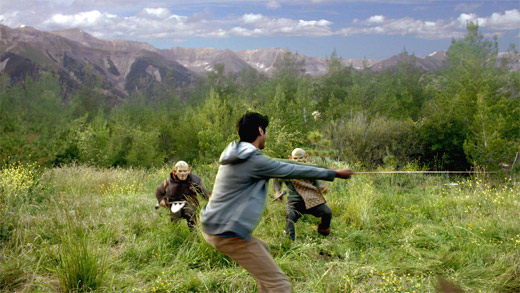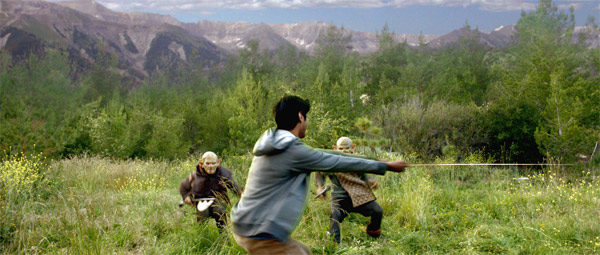Sometimes it's the little things that sell a spot – like the quick composite that establishes the expansive fantasy setting for this good-timey spot touting co-op gameplay in videogame franchise Dungeon Siege III. The compositing and color-grading were handled by Brickyard VFX in Santa Monica. We checked in with lead VFX artist Chris Sonia to see what's new in the compositing suite. Mouse over the frame grab below to see a before-and-after, then scroll down to read the Q&A.

Mouseover frame grab above to compare to original live-action plate
Chris Sonia: We initially met with GreenDot director Luc Schurgers, and discussed needing to enhance the background with additional mountains for a more majestic vibe since the location's horizon was vacant. In terms of shooting, the director could have ultimate flexibility with the ARRI ALEXA camera since the background mountains would be in the distance and we could use still photographs from our library and track to the practical move.
Describe the process of creating and adding a new background image.
Initially, we look for the style of mountains from our catalog and create a rough mockup during the editorial process. When they're happy with the style and the arrangement of the mountain range, we spend time matching the lighting and perspective to the live action plate in Autodesk's Flame. This is critical to keep the composite looking as though it was shot practically. The original raw camera footage is very flat and ultimately we color-corrected the entire conform, working closely with the director on the best palette. The background mountains are then color-corrected to that established look for seamless integration.
What's the secret to a successful composite? What tricks do you use to keep viewers from realizing, consciously or not, that the landscape they're seeing has been created in a computer by some VFX artists?
A combination of the right photograph for the plate that is at the correct perspective, lighting, and scale is critical. From there, color correction and blending tools in Flame will be used for a final polish.
Does the job get easier as technology becomes more powerful? Are any new tools helping you do better, or more efficient, work?
The process is a bit more streamlined when shooting with digital as opposed to film for the conform process and advanced processing speeds, but the fundamental tools to execute this type of work is unchanged. The ease of the color-correction process in Flame has increased exponentially due to advances in the timeline. It now allows you to easily share looks between similar shots and compare these grades within the cut in a speedy fashion.
Tell us about something else in your working environment that boosts your productivity, improves your mood, or just makes the day go by a little easier.
Good people and tequila. That and working in a really cool space – our studio here in Santa Monica was outfitted to match Brickyard Boston's signature vintage-junkyard-chic aesthetic, complete with big neon signs and a 20-foot bar built out of reclaimed church pews.
For more information: www.brickyardvfx.com.
Did you enjoy this article? Sign up to receive the StudioDaily Fix eletter containing the latest stories, including news, videos, interviews, reviews and more.











Leave a Reply